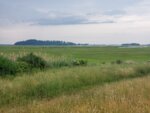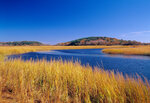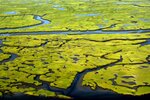



Although many on the North Shore may not realize it, one of the biggest reasons we were probably drawn to live in this region is because of the proximity of the Great Marsh and the environment it affords us. The Great Marsh is the largest salt marsh in New England and includes over 25,000 acres of marsh, barrier beach, tidal river, estuary, mudflat, and upland islands. It extends across the Massachusetts North Shore, from Gloucester to Salisbury. This vast open space of marsh and ocean to the east and north is integral to our lives.
For many, it provides recreational benefits such as boating, fishing, kayaking, and the beaches. Residents and visitors also enjoy the natural beauty, the environmental habitats and wildlife living beside us in the marsh grasses, pools and pannes, dunes and beaches, and creeks and ditches. And although less than in the past, a large number of people rely on the salt marsh to make a living through clamming, marsh haying, fishing, or the view from the restaurant window that makes the food taste even better.
The reality is that all of us have a connection to the presence of the marsh, whether or not we ever utilize its bounty. We know it’s there, this big open area that keeps us free on at least one side from the crowding and confinement experienced by our inland neighbors. We know that within a short distance we can escape our boundaries to a place where we can feel and see, unobstructed, to the horizon.
So, what is the Great Marsh really? Grass and mud and rocks and water and sand and birds and fish? That is correct, but really how they all interact is what makes the salt marsh great. In particular, the humble components of water and sediment are most important in the creation of the Great Marsh.
Several thousand years ago the water created the marsh by piling up offshore the coarser sediments that came down our rivers (primarily the Merrimack River, but also the Parker, Rowley, Ipswich, Essex, and Annisquam rivers) to create the barrier beaches that we all enjoy. These long, narrow ribbons of sand now protect the marsh (and us) from destructive storm waves. The water also carried the finer silts and clays from the rivers to the calmer waters behind these blockades. This finer material then settled out to allow the marsh to build. Eventually the sediment platform grew to the height of the high tide, with the marsh grasses keeping pace.
The vegetated marsh platform as it stands today is very level and uniform. Only an inch or two change in the marsh platform elevation will result in a different species of marsh grass. These grasses are extremely sensitive to the amount of saltwater inundation they receive from the high tide on a daily, weekly, and monthly basis.
Some plant species can only tolerate flooding once a month or less while others can endure more frequent assaults. Assault is an apt term; most of these plants on the high marsh (marsh platform) prefer to exist in an upland, freshwater environment, but have been pushed by competitors to brackish and salty waters of the saltmarsh. Meanwhile, essentially only one species of plant (Spartina alterniflora – saltmarsh cordgrass) inhabits the low marsh, on the banks of the saltmarsh and tidal creeks. But all together, high marsh and low marsh flora, stabilize the marsh sediment and keep it in place. In addition, the roots of all this vegetation from years and decades past further keep the marsh sediment from eroding away.
In fact, most of the biomass of the salt marsh is below ground making it extremely productive and a great carbon sink for greenhouse gasses. Salt marshes are more biologically productive than a tropical rainforest, it’s just all below the surface. Eelgrass occupies the elevation below the low tide reach in the sub-tidal zone. Although in the Great Marsh its acreage has been severely reduced over the last century.
The water also transports nutrients throughout the salt marsh. In addition to the nutrient influx from the rivers and runoff into the Great Marsh, nutrients are redistributed around the estuary by the tides which allows for a wealth of birds, fish, mammals and invertebrates that call the saltmarsh home. The tidal action also helps remove toxins from the system and allows for a variety of unique habitats, including serving as an important refueling and resting stopover on the north Atlantic migratory bird flyway.
The Great Marsh provides a number of ecological services that residents of Cape Ann rely upon, on a daily basis. In addition to being a highly productive environment for wildlife and human activity, the saltmarsh also filters pollutants carried by rainwater runoff from our lawns and roadways to the coast. However, one of the most important functions of the Great Marsh is the protection it gives us from the destruction caused by coastal storms and storm surge waves.
The barrier beaches are the first wave of defense against these events breaking up and diffusing the energy from the pounding waves. The salt marsh itself, its marsh banks, vegetation, and tidal creeks act as the second wave of protection mitigating any further storm damage. Because our Great Marsh is still intact and so expansive and relatively healthy, it works to protect our vulnerable man-made infrastructure (houses, roads, hospitals, water and wastewater distribution systems, etc.) in the developed coastline. This is not the case with many of Massachusetts’ saltmarshes.
The Great Marsh is relatively healthy; there are, however, signs of degradation. We need to be diligent to protect and restore the damaged habitats and functions of the marsh if we want to continue to enjoy its assets. As mentioned above, eelgrass meadows are in extreme danger, less than 10 percent of what was here 100 years ago remains; marsh banks are beginning to erode deeper and at a more rapid rate; sand dunes and barrier beaches have been anthropogenically modified causing greater erosion when coupled with the impairments of climate change; rising seas are inundating the salt marsh platform causing vegetation to die-off and the loss of marsh; and the invasion of non-native, invasive species is everywhere.
The Great Marsh does have many advocates on the North Shore and at the state and federal level. Stakeholders are partnering together, using innovative techniques as well as standard practices to protect, restore, and enhance the Great Marsh and its functions. Much state and federal money has been spent and will continue to flow into the region for this important work. Stewardship for, and knowledge of, the functions of the Great Marsh by all those who care is the greatest tool we have to keep our quality of life and the Great Marsh intact.
Peter Phippen is a hydrogeologist and coastal scientist with 40 years of experience in water resources management. He is currently coordinator of the Eight Towns and the Great Marsh Committee, a division of the MassBays National Estuary Partnership and the Merrimack Valley Planning.